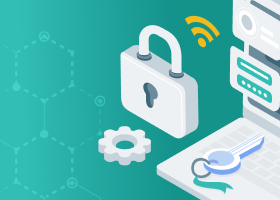Data Backup Strategy Best Practices
Data backup strategy best practices start with keeping data in a secure location that can be readily accessed. The site for data backups should be in a separate physical or cloud location.

Enabling a backup strategy helps protect data losses due to hardware failure, natural disaster, file corruption, malware, or malicious users. In addition, a backup strategy provides guidance on how to set up the suitable systems and processes to minimize time spent trying to recover files, recollect data, or redo any cleaning or analysis.
Seven Backup Strategy Best Practices
- 1. Consider Retention Span
For data governance and storage expenses, retention times should be established for data backups. Retention schedules should map to backup schedules. For instance, keep hourly and daily backups for a week, weekly backups for a month, and monthly backups for a few months or even for years, based on company requirements. - 2. Document Policies and Procedures
Backup policies should be clearly documented. These should cover an explanation of goals and strategies, specifics about what tools and processes are used, roles and responsibilities, backup timing, and retention schedules. - 3. Keep Backups Encrypted and Protected
In addition to the security of backup locations (i.e., cloud, physical), encrypting the files provides additional data protection. - 4. Make Backups Frequently and Regularly
Data backups should be performed regularly, although the frequency may not be the same for all data. Some data may be backed up on an ongoing basis. Other backups may be performed on a periodic basis—daily, nightly, or weekly. - 5. Perform Regular Tests of Backups and Recovery
Data backup tests should be performed periodically—at least on an annual or semi-annual basis. Depending upon the organization’s size and assets, data backup testing could be more frequent. - 6. Use a 3-2-1 Data Backup Strategy
Add extra layers of redundancy for data backups by using a 3-2-1 data backup strategy. The 3-2-1 backup strategy ensures multiple copies of data are backed up and retained.
- Three
Keep three copies of data, the original data copy, and at least two backups. - Two
Use two different storage types. For instance, if data is stored on an internal hard drive, use a secondary device such as an external drive or cloud source. - One
Keep one copy of data offsite.
- 7. Use Remote Storage
A critical factor in your backup solution is setting up remote backups. The ideal is to have backups offsite, but, at a minimum, they should be on a separate system. Data backup can be conducted in the cloud or on a dedicated physical server.
What is a Business Continuity and Disaster Recovery (BCDR) Plan?
A business continuity and disaster recovery (BCDR) plan is a program that establishes the processes and identifies the resources (i.e., systems, people) needed to help an organization respond to a disaster. This means maintaining operations continuity as much as possible and expediting recovery, in the short-term and the long-term. Having a BCDR plan allows organizations to respond to and recover from disasters quickly and with minimal disruption.
Key Steps to Execute a Business Continuity and Disaster Recovery (BCDR) Plan
- Establish and assign roles and responsibilities.
- Conduct a business impact analysis.
- Design the recovery plan.
- Test the plan and backups.
- Execute the plan in the event of a disruption.
- Review, measure and maintain the plan.
Why Organizations Need a BCDR Plan
Reasons that organizations need a BCDR plan are that it:
- Reduces overall risk
- Enables rapid response to disasters, allowing operations to be resumed as quickly as possible
- Facilitates compliance with industry regulations related to data management
Automating Backups
With automatic backups, little or no human intervention is required for backing up and storing data from computers, networks, applications, databases, or systems. However, it is important to remember that automatic backups do not mean that no human involvement is required.
Regular maintenance and upgrades should be performed to ensure that the system is functioning correctly and that backups have not become corrupted in the process. In addition, scans should be performed to identify any new data that should be added to automated data backups, as well as any that should be removed.
Key features that are included in automated backup solutions enable your organization to:
- Automate the execution of backup retention and expiration policies.
- Centrally manage automated backups.
- Configure lifecycle policies that automatically transition backups from archival storage according to a defined schedule.
- Create, apply, and update automated backup policies to meet internal and regulatory compliance requirements.
- Encrypt backed-up data at rest and in transit.
- Enforce data access controls on all backed-up data according to established user privileges.
- Set up schedules (i.e., backup start time, frequency, and window(s)) for backup, by creating customized backup schedules, or choosing from predefined backup schedules.
- Store periodic backups incrementally.
- Use tags to apply backup policies to data.
- Maintain a view of all backups and backup activity logs to facilitate auditing and compliance.
- View the status of backup jobs and restore jobs from a centralized console.
When automating backups, choose one of the following three ways to best suit requirements, or use a combination of these.
- 1. Full backup provides a full clone of selected data sources, including files, folders, applications, and hard drives.
- 2. Differential backup backs up data that was created since the last full backup. A full backup is performed initially and is followed by subsequent backups to capture changes. With differential backups, there are only two backups required for restoration.
In addition to the security of backup locations (i.e., cloud, physical), encrypting the files provides additional data protection. - 3. Incremental backups make an initial full backup, then back up changes since the last backup. While faster to complete, restoration times are slower with incremental backups because multiple backups are required depending on the number performed.
Benefits of Automating Backups
- Eliminate inevitable human error associated with manual backups.
- Expedite recovery in the event of data loss.
- Gain visibility into backups to identify issues with built-in reporting.
- Improve internal and compliance-related auditing and reporting with consolidated records of all backup activities.
- Increase security by including data encryption as part of backups.
- Reduce the amount of valuable IT staff time that is wasted on tedious, manual processes.
- Save time and storage space with synced backups.
- Schedule data in backups to be archived or destroyed according to retention policies.
Select a Method for a Data Backup Strategy
There are a number of options for performing data backups, as well as best practices to guide them. Regardless of the backup strategy selected, the overriding best practice is to keep data backups in a secure location—preferably off-site or in cloud storage.
In the event that a business continuity and disaster recovery plan must be executed, the organization’s backup strategy will impact how quickly and easily operations can be brought back online.
Egnyte has experts ready to answer your questions. For more than a decade, Egnyte has helped more than 16,000 customers with millions of customers worldwide.
Last Updated: 30th August, 2021



